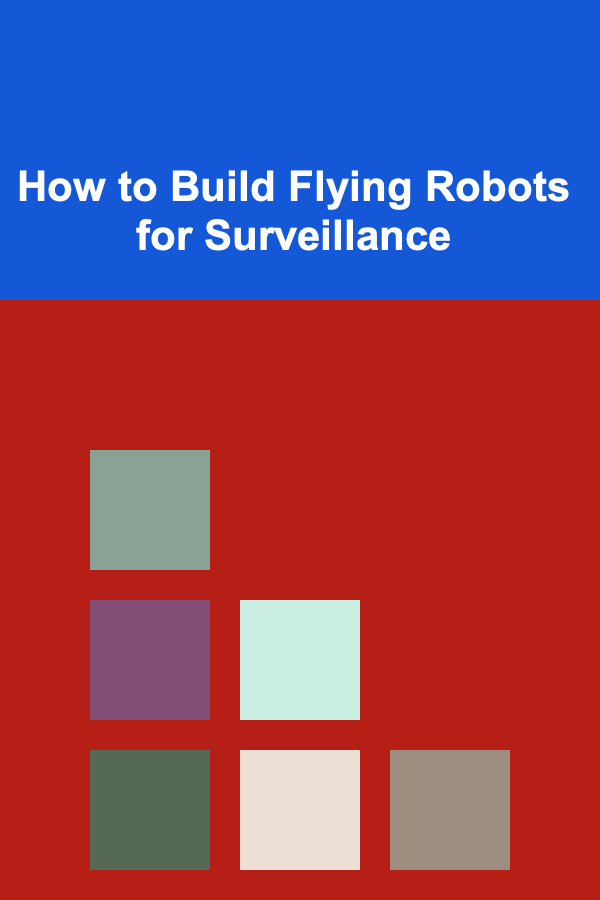
How to Build Flying Robots for Surveillance
ebook include PDF & Audio bundle (Micro Guide)
$12.99$11.99
Limited Time Offer! Order within the next:

Flying robots, also known as drones, are revolutionizing various industries, including surveillance. They offer an aerial perspective that traditional cameras or ground-based systems cannot match. Whether for security, disaster management, wildlife monitoring, or law enforcement, flying robots equipped with surveillance capabilities are becoming essential tools in modern surveillance practices. In this article, we will explore the step-by-step process of building a flying robot specifically designed for surveillance purposes, covering the necessary components, design considerations, and implementation strategies.
Understanding the Need for Flying Robots in Surveillance
Flying robots for surveillance are used in a range of contexts, from monitoring large areas, inspecting infrastructure, providing real-time video feeds, and tracking movement in remote areas. These robots can be used for tasks such as:
- Public Safety and Law Enforcement: Drones help monitor crowds, search for missing persons, and observe potentially hazardous situations.
- Environmental Monitoring: Drones are deployed to survey forests, wildlife reserves, oceans, and other environments.
- Security: Surveillance drones are increasingly used for surveillance of borders, stadiums, events, and private properties.
- Military Applications: Military-grade drones are designed for surveillance in war zones or reconnaissance in hostile areas.
With this wide variety of use cases, it's crucial to design a flying robot that can meet specific surveillance needs efficiently and effectively.
Components Required for Building a Flying Surveillance Robot
Building a flying robot for surveillance involves selecting and integrating multiple components, each serving a vital purpose to ensure the robot operates optimally. These components include the frame, propulsion system, control system, power supply, and sensor suite.
2.1 Frame and Structure
The frame is the backbone of the drone. It must be lightweight yet durable enough to withstand harsh conditions. There are various materials that can be used for the frame, such as carbon fiber, aluminum, and plastic composites. Carbon fiber is highly preferred due to its strength-to-weight ratio and resistance to impact.
The frame must also have enough space to accommodate all the electronics, sensors, and cameras without compromising on flight stability. For surveillance drones, the size and shape of the frame should be optimized for maneuverability and ease of transport, especially when navigating tight spaces or flying at high altitudes.
2.2 Propulsion System
The propulsion system consists of motors, propellers, and electronic speed controllers (ESCs). The number of motors depends on the design of the drone. Most surveillance drones are quadcopters (four motors) or hexacopters (six motors) for added stability and redundancy in case of motor failure.
The motor size and power depend on the drone's weight, with larger drones requiring more powerful motors to carry heavier payloads, such as high-definition cameras or sensors. The propellers should be chosen based on the drone's size and weight; larger propellers can provide better lift but may reduce maneuverability.
2.3 Control System
The control system consists of the flight controller, sensors (such as accelerometers, gyroscopes, and barometers), and GPS modules. The flight controller is the brain of the drone, responsible for stabilizing the drone, processing inputs from sensors, and ensuring that the drone responds accurately to control commands.
For surveillance drones, the flight controller should have features like geofencing, GPS waypoints, and automatic return-to-home functions to enhance operational efficiency and safety. The sensors play a vital role in stabilizing the flight, helping the drone stay steady during aerial surveillance operations.
2.4 Power Supply
The power supply is a critical component for ensuring that the drone can fly for a sufficient duration. Drones for surveillance typically use lithium-polymer (LiPo) batteries due to their high energy density and light weight. The battery should be chosen based on the drone's weight and power requirements.
It is also essential to consider battery life in relation to the surveillance mission. Surveillance drones often need to fly for extended periods, so selecting high-capacity batteries or integrating additional power solutions like solar panels or backup battery systems can help maintain a longer flight duration.
2.5 Sensor Suite
The sensor suite is perhaps the most important component of a surveillance drone. Depending on the mission requirements, the sensors could include:
- Cameras: High-definition cameras (HD, 4K, or thermal) are commonly used for surveillance. Cameras may have features such as zoom lenses, night vision, and gimbals to stabilize the footage.
- Thermal Cameras: These cameras detect infrared radiation and create thermal images, which are invaluable in detecting heat signatures in low visibility conditions (such as during the night or in fog).
- LIDAR: LIDAR (Light Detection and Ranging) can be used to create 3D maps of terrain, which is useful for surveying large areas.
- Radar: Radar systems are beneficial for detecting objects or movement at a distance, especially when visibility is compromised.
These sensors can be mounted on gimbals or stabilizers to reduce vibrations and ensure smooth footage during surveillance missions.
2.6 Communication System
To enable real-time surveillance, the drone must be equipped with a communication system capable of transmitting video feeds and telemetry data back to the operator. Typically, drones use Wi-Fi, radio frequency (RF) systems, or 4G/5G LTE communication systems for long-range control and data transfer.
For longer surveillance missions, satellite communication or mesh network systems can be employed, ensuring consistent communication even in remote areas where conventional networks might not be available.
Design Considerations for Surveillance Drones
When designing a flying robot for surveillance, there are several factors that should be carefully considered to ensure the drone's effectiveness, safety, and operational efficiency.
3.1 Flight Stability and Control
Flight stability is essential for capturing clear footage and performing accurate surveillance tasks. A drone with poor flight stability can lead to shaky footage or even accidents. To achieve stability, the drone must have a robust flight controller and high-quality sensors that can adjust in real time based on environmental conditions such as wind, temperature, and altitude.
Additionally, redundant control systems and sensors should be incorporated to ensure the drone remains operational in case of failure. For instance, having an extra motor or a fail-safe return-to-home feature can prevent loss of the drone in critical situations.
3.2 Autonomous Capabilities
Surveillance drones often need to operate autonomously over long distances. This requires the integration of autonomous flight features such as GPS waypoint navigation, geofencing, obstacle avoidance, and automatic return-to-home. These capabilities enable the drone to fly a set path without constant input from the operator, freeing up resources for other surveillance tasks.
Autonomous drones can also be equipped with machine learning algorithms that allow them to recognize specific objects, faces, or movements, making them even more efficient in certain surveillance applications.
3.3 Weather Resistance
Drones used for surveillance must be weather-resistant to handle varying environmental conditions. Many surveillance missions take place outdoors, where wind, rain, or snow could pose a challenge to flight stability. To mitigate this, drone components should be selected based on their resistance to water and environmental stress.
Additionally, the drone's flight controller should be capable of adjusting the flight path based on environmental conditions, such as winds or temperature changes.
3.4 Payload Capacity
Surveillance drones often carry various payloads, including cameras, sensors, and other equipment. Therefore, it is essential to design the drone with an adequate payload capacity to ensure it can carry the required equipment without compromising flight stability or battery life.
Ensuring that the drone's frame and propulsion system are robust enough to carry additional sensors or cameras is vital. Payloads can vary from lightweight HD cameras to heavier sensors like LIDAR or thermal cameras, so the drone's design should be flexible enough to accommodate different setups.
3.5 Data Security and Privacy
When building a surveillance drone, it is critical to address data security and privacy concerns. Surveillance drones collect sensitive data, including video footage, images, and GPS coordinates. This data should be securely encrypted during transmission to protect against hacking or unauthorized access.
Additionally, operators must ensure that the drone complies with local laws and regulations regarding privacy and surveillance. Unauthorized surveillance could lead to legal consequences, so it's essential to design drones that adhere to legal frameworks and ethical guidelines.
Building the Drone: A Step-by-Step Guide
4.1 Assembling the Frame
The first step in building a surveillance drone is to assemble the frame. Start by selecting the right material (typically carbon fiber or plastic) and cutting it into the appropriate shape. Ensure that the frame has mounting points for the motors, sensors, and cameras. Make sure the frame is lightweight yet sturdy enough to handle the payload.
4.2 Installing Motors and Propellers
Once the frame is assembled, the next step is to install the motors and propellers. Attach the motors securely to the frame and connect them to the electronic speed controllers (ESCs). Choose the appropriate size and pitch of propellers based on the weight of the drone and the required flight duration.
4.3 Mounting the Flight Controller and Sensors
Next, mount the flight controller at the center of the frame for optimal stability. Attach sensors like the accelerometer, gyroscope, and GPS module to their respective positions on the drone. Make sure that the wiring is secure and that there is no interference with the motors or propellers.
4.4 Setting Up the Camera and Sensor Suite
The camera and sensor suite should be mounted on a gimbal or stabilizer to ensure smooth footage. Position the camera in a way that allows for optimal field of view and easy access for adjustments. Connect the cameras and sensors to the flight controller, ensuring that the video feed can be transmitted in real time.
4.5 Connecting the Power System
Once all the components are in place, connect the power system. Install the LiPo battery and secure it in place. Ensure that the battery is correctly wired to the flight controller and motors, and check that all components are receiving adequate power.
4.6 Testing the Drone
Before the final flight test, perform a pre-flight check to ensure all systems are functioning properly. Test the motors, flight controller, and sensors. Conduct short test flights to assess the drone's stability and performance, making adjustments as needed.
Conclusion
Building a flying robot for surveillance requires a combination of mechanical, electrical, and software engineering skills. By selecting the right components, designing for stability, and integrating autonomous and data-security features, you can create an effective surveillance drone that meets the needs of modern surveillance tasks.
The demand for drones in surveillance will continue to grow as technology improves. With the right design considerations and careful attention to detail, flying robots will play an increasingly important role in enhancing safety, security, and operational efficiency across a variety of sectors.
Other Products

How to Have a Family DIY Home Improvement Project
Read More
How to Organize Your Wedding Music Playlist
Read More
How to Sell Handmade Knitted Toys on Etsy: A Comprehensive Guide
Read More
How to Serve Food Buffet-Style for a Relaxed Home Party
Read More
How to Stage Your Kitchen to Make It Look More Spacious and Modern
Read More